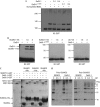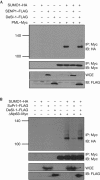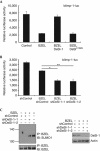DeSUMOylating isopeptidase: a second class of SUMO protease
- PMID: 22370726
- PMCID: PMC3321169
- DOI: 10.1038/embor.2012.3
DeSUMOylating isopeptidase: a second class of SUMO protease
Abstract
The modification of proteins by small ubiquitin-like modifier (SUMO) is crucial for the regulation of diverse cellular processes. Protein SUMOylation is reversed by isopeptidases, collectively known as deSUMOylases. Only one family of SUMO-specific proteases has been described so far: the sentrin-specific proteases (SENP). Here, we identify and characterize a new deSUMOylase, which we have named DeSI-1 (DeSumoylating Isopeptidase 1). We describe BZEL—a new transcriptional repressor—as substrate of DeSI-1. DeSI-1 catalyses the deSUMOylation, but not the deubiquitination, of BZEL. Furthermore, the SENP substrates PML and ΔNp63 are not deSUMOylated by DeSI-1, suggesting that SENP and DeSI enzymes recognize different sets of substrates. Together, these data identify a second class of SUMO proteases.
Conflict of interest statement
The authors declare that they have no conflict of interest.
Figures





Similar articles
-
SUMO Signaling by Hypoxic Inactivation of SUMO-Specific Isopeptidases.Cell Rep. 2016 Sep 13;16(11):3075-3086. doi: 10.1016/j.celrep.2016.08.031. Cell Rep. 2016. PMID: 27626674
-
Assays of SUMO protease/isopeptidase activity and function in mammalian cells and tissues.Methods Enzymol. 2019;618:389-410. doi: 10.1016/bs.mie.2019.01.005. Epub 2019 Feb 21. Methods Enzymol. 2019. PMID: 30850061
-
Crystal structure of DeSI-1, a novel deSUMOylase belonging to a putative isopeptidase superfamily.Proteins. 2012 Aug;80(8):2099-104. doi: 10.1002/prot.24093. Epub 2012 May 22. Proteins. 2012. PMID: 22498933
-
Emerging roles of desumoylating enzymes.Biochim Biophys Acta. 2009 Mar;1792(3):155-62. doi: 10.1016/j.bbadis.2008.12.008. Biochim Biophys Acta. 2009. PMID: 19162180 Review.
-
SUMO proteases as potential targets for cancer therapy.Postepy Hig Med Dosw (Online). 2017 Dec 8;71(0):997-1004. doi: 10.5604/01.3001.0010.6667. Postepy Hig Med Dosw (Online). 2017. PMID: 29225200 Review.
Cited by
-
Emerging roles of sumoylation in the regulation of actin, microtubules, intermediate filaments, and septins.Cytoskeleton (Hoboken). 2015 Jul;72(7):305-39. doi: 10.1002/cm.21226. Epub 2015 Aug 22. Cytoskeleton (Hoboken). 2015. PMID: 26033929 Free PMC article. Review.
-
Revised annotation and extended characterizations of components of the Chlamydomonas reinhardtii SUMOylation system.Plant Direct. 2020 Sep 28;4(9):e00266. doi: 10.1002/pld3.266. eCollection 2020 Sep. Plant Direct. 2020. PMID: 33015534 Free PMC article.
-
Function and regulation of SUMO proteases.Nat Rev Mol Cell Biol. 2012 Dec;13(12):755-66. doi: 10.1038/nrm3478. Nat Rev Mol Cell Biol. 2012. PMID: 23175280 Free PMC article. Review.
-
Modulation of Ubiquitin Signaling in Innate Immune Response by Herpesviruses.Int J Mol Sci. 2022 Jan 1;23(1):492. doi: 10.3390/ijms23010492. Int J Mol Sci. 2022. PMID: 35008917 Free PMC article. Review.
-
The role of SUMOylation during development.Biochem Soc Trans. 2020 Apr 29;48(2):463-478. doi: 10.1042/BST20190390. Biochem Soc Trans. 2020. PMID: 32311032 Free PMC article. Review.
References
-
- Mukhopadhyay D, Dasso M (2007) Modification in reverse: the SUMO proteases. Trends Biochem Sci 32: 286–295 - PubMed
-
- Gill G (2004) SUMO and ubiquitin in the nucleus: different functions, similar mechanisms? Genes Dev 18: 2046–2059 - PubMed
-
- Johnson ES (2004) Protein modification by SUMO. Annu Rev Biochem 73: 355–382 - PubMed
-
- Geiss-Friedlander R, Melchior F (2007) Concepts in sumoylation: a decade on. Nat Rev Mol Cell Biol 8: 947–956 - PubMed
Publication types
MeSH terms
Substances
LinkOut - more resources
Full Text Sources
Other Literature Sources
Molecular Biology Databases

